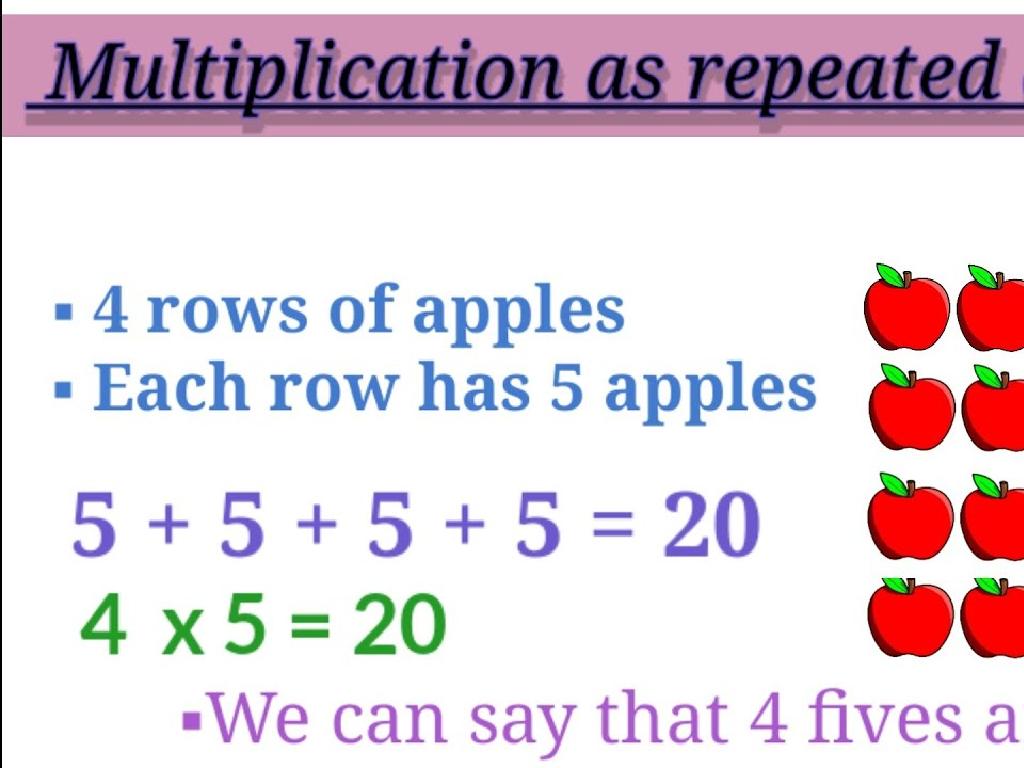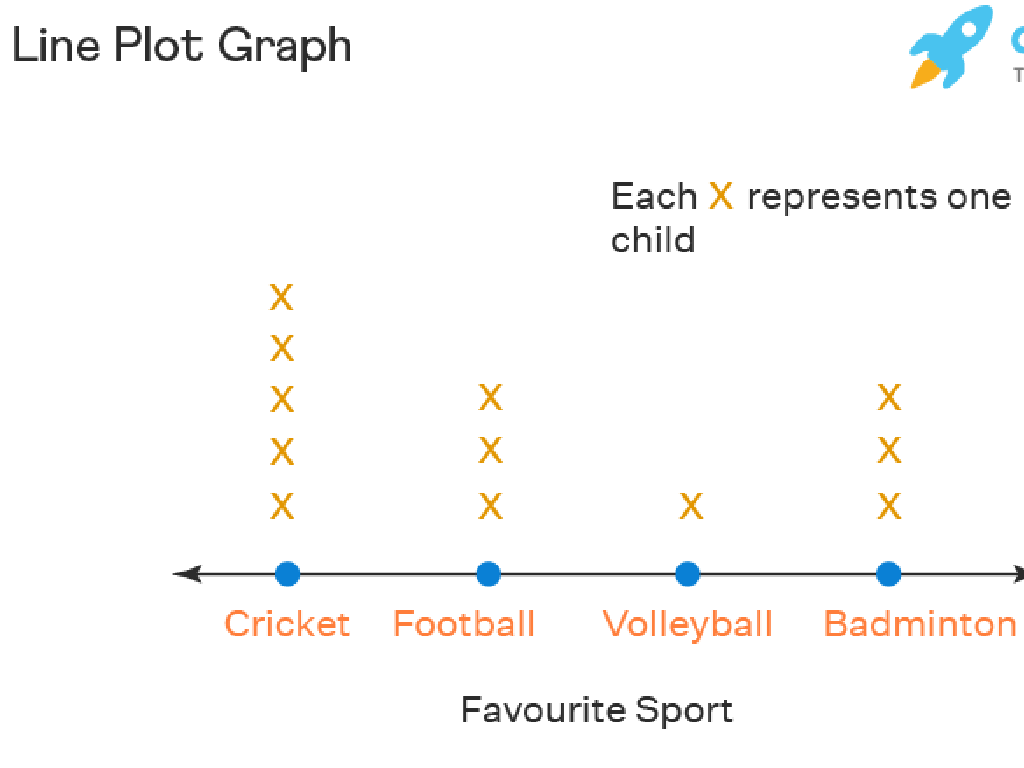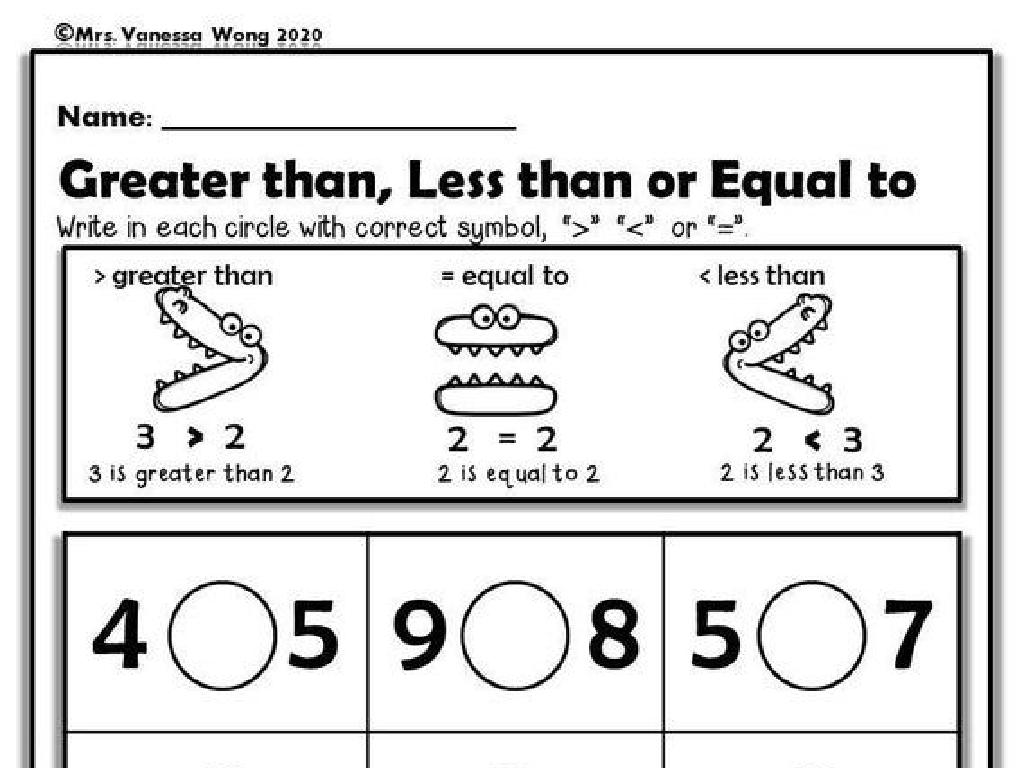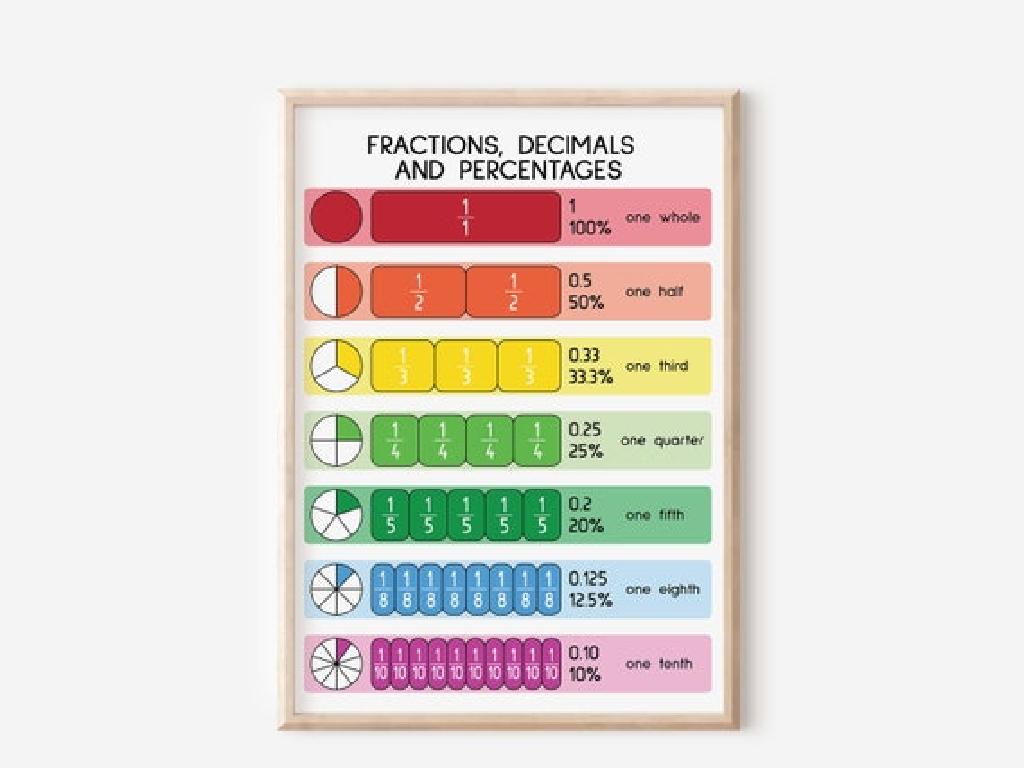Reciprocals
Subject: Math
Grade: Fifth grade
Topic: Fractions And Mixed Numbers
Please LOG IN to download the presentation. Access is available to registered users only.
View More Content
Today’s Adventure: Exploring Reciprocals!
– What is a reciprocal?
– A reciprocal is a flipped fraction, like 1/2 becomes 2/1
– Exploring fractions & mixed numbers
– Fractions represent parts of a whole; mixed numbers combine whole numbers and fractions
– Reciprocals in daily life
– Cooking uses fractions: 1/2 cup sugar, flip for recipe adjustments
– Practice finding reciprocals
– Turn 3/4 into 4/3, or 1 2/3 into 3/1 1/2
|
Introduce the concept of reciprocals by explaining that it’s simply flipping the numerator and denominator of a fraction. Ensure students understand basic fractions and mixed numbers, as reciprocals build on this knowledge. Discuss how fractions are used in everyday life, such as in cooking, to make the concept relatable. Provide examples and guide students through exercises to find reciprocals of given fractions and mixed numbers, reinforcing their understanding of the concept.
Understanding Reciprocals in Fractions
– A fraction represents part of a whole
– Numerator and denominator explained
– Top number is numerator, bottom is denominator
– Reciprocals: flipping fractions
– Reciprocal is made by exchanging the numerator and denominator
– Examples: 1/2 becomes 2/1
– 3/4 becomes 4/3, 5/8 becomes 8/5
|
Begin by explaining that a fraction represents a part of a whole, such as a slice of pizza out of a whole pizza. Clarify the terms numerator and denominator, with the numerator indicating how many parts we have and the denominator showing the total number of equal parts the whole is divided into. Introduce the concept of reciprocals, which is simply flipping the numerator and denominator of a fraction. Provide examples of reciprocals and ensure students understand that the reciprocal of a fraction is another fraction that when multiplied with the original, results in 1. Encourage students to practice finding reciprocals of different fractions.
Understanding Reciprocals
– Reciprocal flips fraction numbers
– Swap the top and bottom numbers, like turning 1/2 into 2/1
– Every number has a reciprocal
– This is true for all numbers except zero
– Zero does not have a reciprocal
– Examples of reciprocals
– For 1/2, the reciprocal is 2/1; for 3/4, it’s 4/3
|
This slide introduces the concept of reciprocals in the context of fractions. A reciprocal is found by exchanging the numerator and denominator of a fraction. It’s important to note that while most numbers have reciprocals, zero is the exception because dividing by zero is undefined. Use examples to illustrate the concept, such as showing that the reciprocal of 1/2 is 2/1, and the reciprocal of 3/4 is 4/3. Encourage students to practice with different fractions and to remember that finding a reciprocal is simply flipping the fraction upside down.
The Importance of Reciprocals
– Reciprocals in fraction division
– To divide fractions, multiply by the reciprocal of the divisor.
– Understanding ratios and proportions
– Ratios compare two quantities; reciprocals help in finding equivalent ratios.
– Application in advanced math
– Concepts like slopes of lines involve reciprocals.
– Reciprocals in real-life scenarios
– Cooking or mixing paints requires reciprocals to measure proportions correctly.
|
Reciprocals are a fundamental concept in mathematics that are essential for understanding and performing operations with fractions. They play a crucial role in dividing fractions, where instead of dividing, we multiply by the reciprocal of the divisor. Reciprocals also help students grasp the concept of ratios and proportions, which are comparisons of two quantities. As students progress in math, they will encounter reciprocals in more advanced topics, such as calculating the slope of a line. Moreover, reciprocals have practical applications in everyday life, such as adjusting recipes while cooking or mixing colors in art. Encourage students to think of situations where they might need to use reciprocals and share their ideas in class.
Finding Reciprocals
– Exchange numerator and denominator
– For 5/6, flip to get 6/5
– Convert mixed numbers first
– Change 2 1/3 to 7/3 before flipping
– Reciprocal of 5/6
– Flip 5/6 to get its reciprocal: 6/5
– Reciprocal of 2 1/3
– After converting, flip 7/3 to get 3/7
|
To find a reciprocal, simply switch the top and bottom numbers of the fraction. If dealing with a mixed number, like 2 1/3, convert it to an improper fraction first by multiplying the whole number by the denominator and adding the numerator. For 2 1/3, multiply 2 (whole number) by 3 (denominator) and add 1 (numerator) to get 7/3. Then find the reciprocal by flipping it to 3/7. Practice with the class by finding the reciprocal of 5/6 and 2 1/3. Have students explain the process to reinforce their understanding. This exercise will help solidify the concept of reciprocals and their role in operations with fractions.
Class Activity: Reciprocal Race
– Pair up for reciprocal finding
– Find reciprocals of fractions
– Flip the numerator and denominator
– Display answers on whiteboards
– Win a prize for finishing first!
|
This activity is designed to make learning about reciprocals fun and engaging. Students will work in pairs to reinforce the concept of reciprocals by practicing with actual fractions. Provide each pair with a set of fraction cards. They will flip the numerator and denominator of each fraction to find its reciprocal and write the answer on their whiteboard. Monitor the class to ensure that students are correctly finding reciprocals. The first pair to correctly find all reciprocals wins a small prize. This encourages teamwork and quick thinking. Possible variations of the activity could include a reciprocal relay race, reciprocal matching game, or creating a reciprocal flip book.
Wrapping Up: Reciprocals
– Recap of reciprocal concepts
– A reciprocal is 1 divided by the number, e.g., reciprocal of 2/3 is 3/2
– Practice is key to mastery
– Homework: Reciprocal worksheet
– Complete the worksheet on finding reciprocals of fractions and mixed numbers
– Keep practicing at home!
– Try to find reciprocals of everyday fractions
|
As we conclude today’s lesson on reciprocals, remind students of the key concept: a reciprocal is simply flipping a fraction over. Emphasize the importance of practice in mastering the concept of reciprocals, as it is fundamental to their understanding of fractions and division. For homework, students are assigned a worksheet that will reinforce their skills in finding reciprocals for both fractions and mixed numbers. Encourage them to also look for opportunities to practice this skill in real-life situations, such as cooking or dividing items evenly. The goal is for students to become comfortable with the idea of reciprocals and to recognize their utility in various mathematical contexts.






